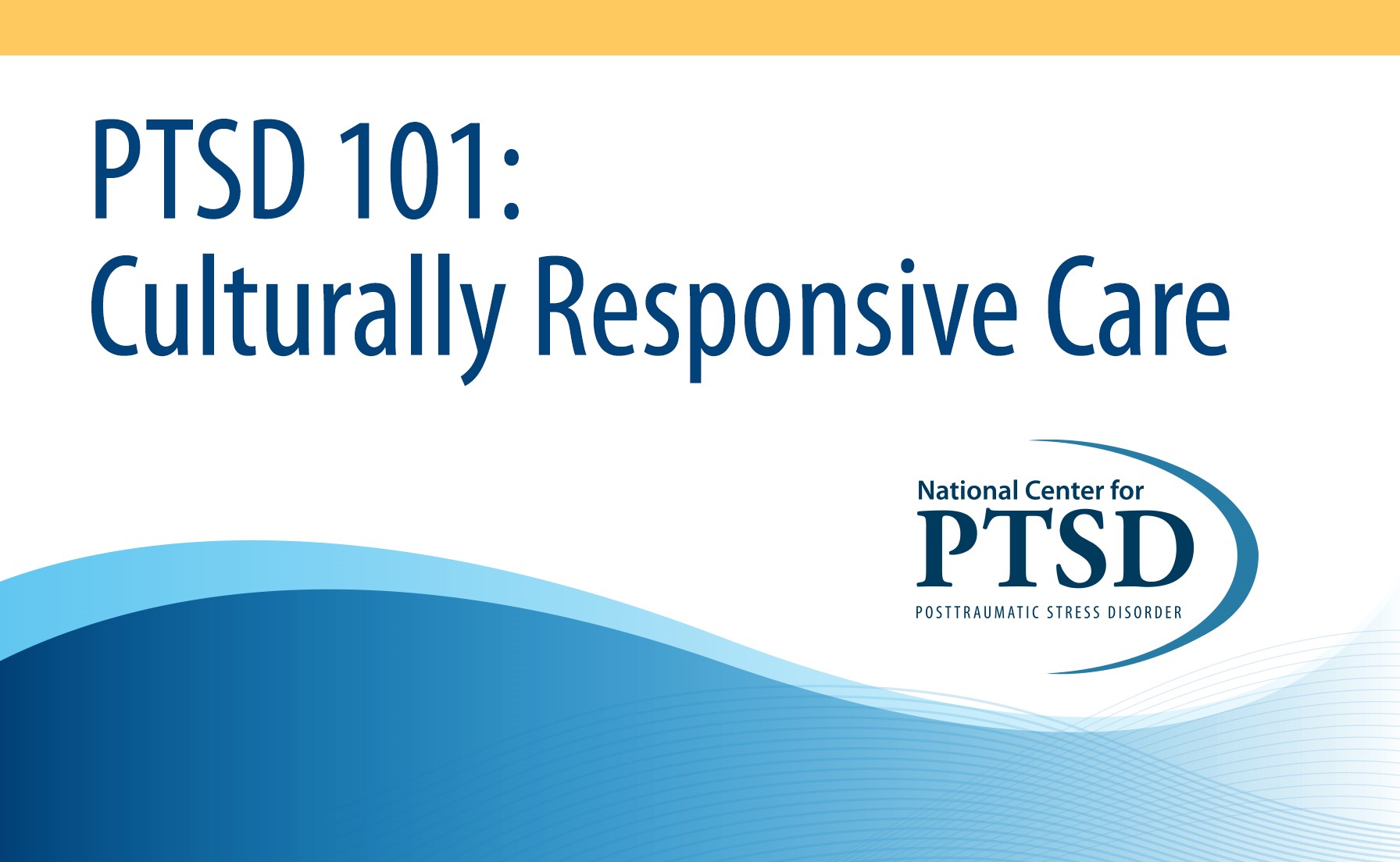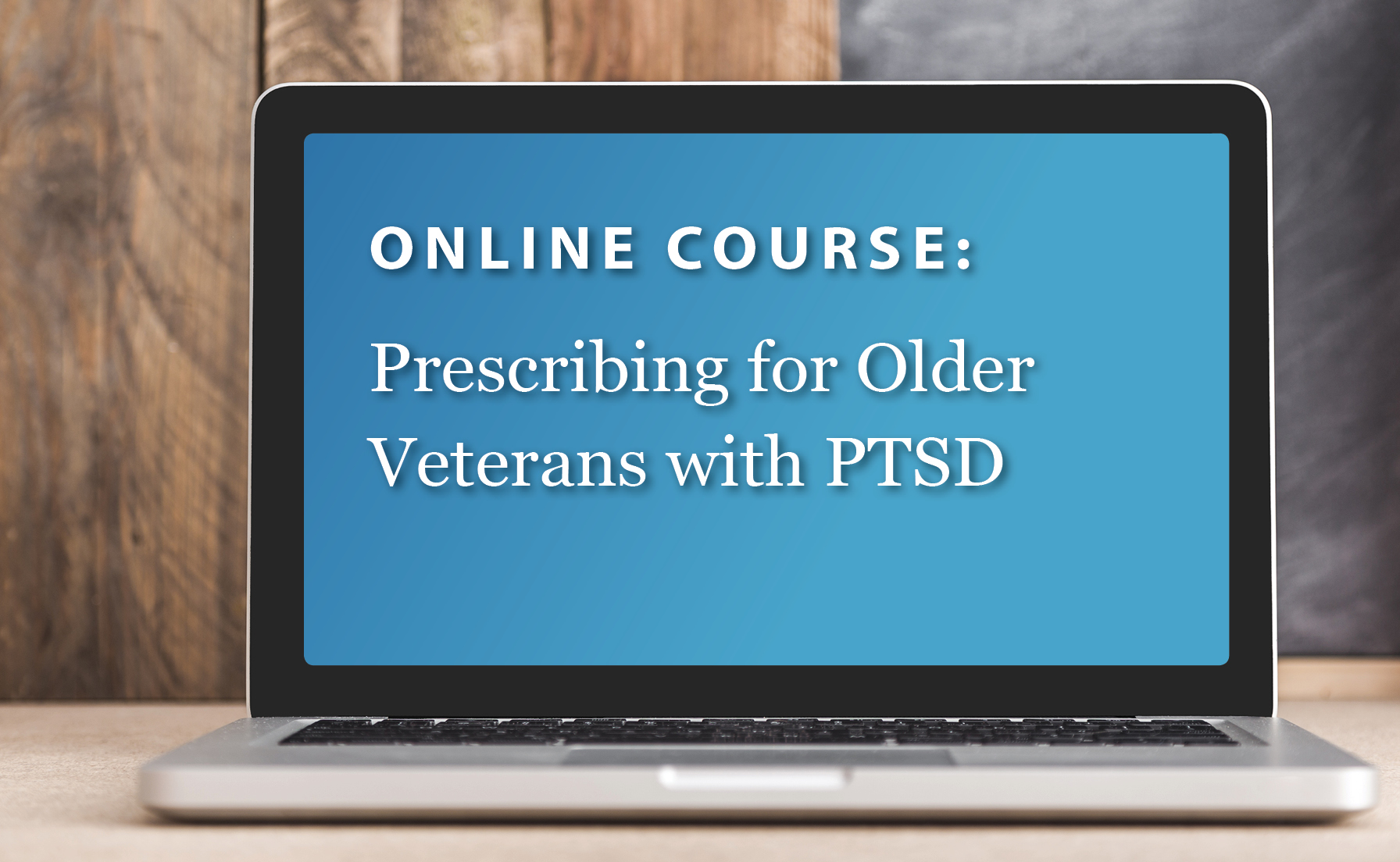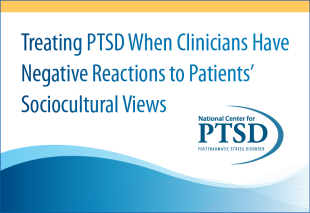PTSD: National Center for PTSD
Provider Guide to Addressing Patient Reactions to Race-Based Violence During PTSD Treatment
Provider Guide to Addressing Patient Reactions to Race-Based Violence During PTSD Treatment
Evidence-based, manualized therapies have been developed to treat PTSD (1). The ability to focus on distress related to the traumatic event as outlined in our evidence-based treatments may be compromised when major current events such as race-based violence impact patients in the midst of treatment. Race-based violence refers to violence targeted at people based on their skin color, language, culture and physical features. Trying to navigate the need to continue a course of PTSD treatment while making room to process the effects of race-based violence can be clinically challenging.
This article is intended to help guide providers' case formulation and treatment decision-making processes when trying to balance ongoing treatment for PTSD that incorporates therapeutic attention to emerging patient needs during race-based crises versus deciding when it is clinically wise to diverge and offer non-protocol, supplemental interventions. This guidance is intended to be applicable to all patients with PTSD addressing consideration of the full spectrum of patients' prior experiences, perspectives and needs.
In This Article
Case Formulation
Case formulation is a patient-centered, collaborative process between providers and patients. This process allows providers to continuously assess a patient's current and emerging needs throughout therapy. This ongoing assessment then allows providers to tailor treatment accordingly. A primary benefit of the case formulation approach is that it provides real-time, global, clinical assessment and guidance that enables providers to flexibly navigate the infinite range of complex clinical situations that may present during treatment.
The collaborative case formulation approach may be particularly helpful in understanding a patient's complex and nuanced reactions to unfolding race-based violence. Continuous assessment of evolving patient needs is important. This may involve providing multiple opportunities for discussion of a patient's response to race-based violence or the impact of racism over the course of treatment. Sometimes the timing for discussions about reactions to race-based violence might not be appropriate. The patient has the right to decline to talk about related thoughts and feelings. Particularly in the early stages of developing a new patient-therapist relationship, it may be difficult to have conversations about topics such as racism. Providing an open door for the patient to discuss reactions and distress in future sessions may be sufficient in the moment. Expressing willingness to check in again over time can keep the door open for further discussion (2).
To best understand the impact of race-based violence on PTSD, we recommend open-ended questions starting from a place of no assumptions about what the patient is both thinking and feeling.
- A provider might begin the conversation broadly: "There has been much media coverage and national conversation on [name event]. What thoughts or reactions about this do you want to spend some time on today?"
- A provider might also wonder if the patient is engaging in these conversations elsewhere and check in about the patient's support system (or lack thereof) as a way to begin the conversation. "Have you been having conversations about [insert event] with others? In what ways have the conversations been helpful? Are there ways in which the conversations have been less helpful?"
- A therapist may also normalize reactions to race-based violence and begin a conversation focused more on querying emotional reactions. "Many people have been experiencing strong feelings about [insert event]. I wanted to check in and see how you have been doing these very stressful times. How have you been feeling?"
- Another option might be to tie the discussion in with the patient's PTSD specifically. "Race-based violence can impact mental health in many ways. I'm wondering if you noticed changes in your own symptoms of distress? Is this something you want to spend time working together on today?""
The manner in which the case formulation process is conducted is critical for its success. We offer the following clinical hints for creating an environment suitable for these conversations.
Honor the patient's experience
Take the time to contemplate the patient's answers. Allow the patient the opportunity to experience emotions. Sit with the information provided by the patient. Provide plenty of space for the patient to add to their narrative.
Listen to and hear the patient
Reflect back to the patient what you, the provider, heard. Be sure to hear your patient's voice speaking their truth. For many patients, this interaction may be their only opportunity to express thoughts and emotions and an important opportunity for change. Acknowledge that, if you do not share your patient's cultural, racial or ethnic background, you cannot truly understand their pain. Statements like, "I totally understand how you feel" can be invalidating. Do not try to dismiss their experiences or minimize their perspective.
Back to topConsiderations for Case Formulation
Understanding the source of the patient's distress is necessary to formulate effective interventions. Below, we outline some important considerations to factor into these discussions. These considerations will help the provider understand whether elevations in patient distress: 1. represent an increase in existing PTSD symptoms; 2. constitute an entirely new trauma to consider; or, 3. are more attributable to a different diagnosis and an additional set of symptoms. Information gathered through these considerations will inform treatment decisions.
Consider the patient's exposure to race-based violence
The patient's immediate proximity to race-based violence is important to assess, including the extent of exposure to media images and/or direct personal exposure to ongoing events. Further, the patient's prior experiences with the larger, systemic context of the violence may also contribute uniquely to PTSD symptoms and these experiences may be quite variable across patients. It is important to note that there may be an enhanced psychological impact on a person of Color because the chronic nature of pervasive racism may amplify the effects of race-based violence on PTSD symptoms (3,4).
Consider the patient's interpretation of events
Each patient will have different experiences and related thoughts, beliefs and perceptions about current national events and tragedies. Consider a collaborative discussion about event-related beliefs and whether those beliefs about national events and tragedies are 100% accurate as part of the treatment process. This determination can be difficult because "inaccurate" beliefs are often based in fact and certainly based in personal experience with accompanying emotional salience, which is important to validate for the patient. However, inaccurate beliefs often causesignificant distress and therefore can be an excellent target for intervention. As providers, we cannot modify facts, but we can help patients to change inaccurate thoughts and, in doing so, can greatly reduce distress. Helping patients generalize skills learned in PTSD therapy to modifying event-related beliefs may be effective in reducing distress (5)
In addition to querying event-related beliefs, it is helpful to assess the impact of recent events on worldviews more broadly. It is important not to assume how current events influence patients' belief systems. Media coverage of violence nationwide specifically might serve as evidence to support negative and inaccurate worldviews related to the patient's PTSD. Aspects of race-based events may mean different things to different people. For some, protests are a sign of optimism and hope that change could happen or that people are listening. For others, protests may evoke a sense of danger—there may be a risk of property destruction, and violence or a sense that people are unsafe. Behaviors related to these worldviews, such as risky behavior or social withdrawal, may increase and pose additional targets for both cognitive and behavioral intervention.
Consider similarities between race-based events and the index trauma
There may be considerable overlap between the current race-based violence and the trauma that caused the patient's PTSD. Experiences of racism and discrimination may have influenced how the original index trauma was experienced and processed. Aspects of the events unfolding nationally, such as witnessing violence, may be particularly salient and trigger PTSD symptoms. Therapeutic attention to the details of the current events that are reminiscent of the index trauma could easily be incorporated into trauma-focused cognitive work (e.g. Cognitive Processing Therapy (CPT); 6) or into exposure-based PTSD therapy (e.g. Prolonged Exposure (PE); 5).
Consider new and/or amplified emotional reactions
Emotional reactions may change and fluctuate over time, particularly in times of crisis when the situation is very fluid. Checking in repeatedly over time and in different ways can be very helpful.
- Fear: Assessing the patient's level of fear during race-based violence is important. Following exposure to violence during civil unrest in Ferguson, MO, there was a clear relationship between experiencing fear (fear of injury to oneself/loved ones, for family's safety, and for one's life/loved ones' lives) and negative mental health outcomes such as PTSD and depression. Exposure to media coverage also elicited strong reactions and was related to poor mental health outcomes (7). For patients of Color, events involving race-based violence may amplify fear of becoming victims of such violence and evoke fear related to prior experiences and losses within their own communities, including events that may not have received national attention.
- Anger: Anger occurs on a continuum and plays an important role in galvanizing effort and motivating positive change—critical factors driving civil unrest. Indeed, anger facilitates growth after posttraumatic stress associated with race-based violence (8). Understanding the role of anger as empowering and a potential agent of change is important. Equally important is discriminating anger from aggression and hostility, which are less helpful in achieving positive change (9). Notably, we must recognize that providers may process patient anger differently based on the sex, race, ethnicity, and age of a patient and self-monitor for any potential bias. Anger expressed by women and people of Color tends to be pathologized more than anger expressed by men and White people (10,11). Identifying cognitions underlying anger may help ascertain if the anger is serving the function of avoiding other emotions such as fear, sadness or hopelessness.
- Grief: The prominent media coverage of race-based killings may amplify prior experiences of grief and traumatic losses for patients who have suffered through traumas that also involved loss of life—all too common in the Veteran population. For patients of Color, grief may be intertwined with experiences of oppression and racism, amplifying the effects of loss (12). Recognizing the patient's grief and providing space for processing that grief during the session, identifying additional resources to cope with grief, or assigning at-home activities may be beneficial.
- Hopelessness: For some patients, current events may reinforce feelings of hopelessness and a belief that nothing will ever change. Hopelessness has been associated with depression, anxiety, and suicidality, as well as PTSD (13). With race-based violence, it may be helpful to acknowledge the seemingly hopeless nature of systemic racism while simultaneously engendering hope by encouraging patients to identify ways in which they, and others, may contribute to resisting oppression or fostering change (14). Listening for beliefs such as "I have no control," or "It will never get better," and helping patients to identify realistic ways in which they can take control, foster change and take care of themselves may help to combat hopelessness.
- Consider strengths and resources: It is important to assess the patient's coping strategies (adaptive and maladaptive), current resources and supports, and ongoing stressors. How might existing strategies be applied in this current situation? Are they as helpful in times of crisis? Are there ways they could be adapted to meet current needs? Social support may be particularly important in buffering the effect of trauma more broadly (15). Specific questions may include: Are the patient's views matched to those of their support systems? Is the patient able to utilize typical supports? Strife and tension within communities around how to respond to race-based violence, along with the need to coexist and rebuild after significant ruptures in trust, respect, safety and alliance presents unique challenges. Prior coping strategies and usual supports may be unavailable or less effective which may alter treatment planning or mitigation strategies.
Using Case Formulation in Treatment
As the provider determines the impact of the event on the patient, they then must incorporate this information into their treatment plan. Providers will need to decide if and when to prioritize: 1. current event-related distress over ongoing PTSD therapy; 2. continuing with the PTSD protocol; or, 3. integrating attention to distress over current events into PTSD therapy. The decision-making process is collaborative and dynamic. Decisions regarding treatment priorities may change over time as national events unfold and patients' reactions and distress levels evolve.
Therapists might begin by asking themselves a few overarching questions: Can new information provided by the patient be wrapped into ongoing PTSD therapy? Do we need to diverge from the PTSD therapy for a session or two, or pause treatment briefly? Am I ensuring that if I diverge from or pause PTSD treatment, I have a path for returning to treatment without reinforcing avoidance? Should I adapt treatment? And, if so, how and for how long? Should I offer additional resources or augment treatment? Signs that it may be wise to diverge and pause treatment, adapt treatment, or offer a supplemental treatment include: 1. when the focus on event-related distress is preventing focus on the index trauma; 2. when a patient does not have the external and internal resources to manage event-related distress; and, 3. when thoughts and feelings about these events cannot be incorporated into the existing treatment modality.
Continuing Education Course
Treating PTSD When Clinicians Have Negative Reactions to Patients' Sociocultural Views
This online course provides strategies to help clinicians provide evidence-based care for PTSD in cases where they may have a negative reaction to their patients' sociocultural views.
Therapists can return to these questions as needed to modify their treatment plan over time based on patients' responses and priorities. In sum, the provider should assess patients' reactions to race-based violence and, if needed, collaboratively create a plan to address event-related distress while still providing a clear path for continuing or returning to PTSD treatment.
An important factor to keep in mind is to exercise caution in identifying inaccurate thoughts and beliefs about race-based violence. It is not helpful to label a person's perception or description of their experience and struggle as inaccurate. The ultimate decision about whether a belief is accurate is the patient's. The provider's job is to help the patient weigh evidence and help them determine whether a belief is a fact or if there is room for modification.
This decision-making process is a conversation and requires collaboration between patient and therapist. Validation of evidence that is accurate can be quite validating for patients and can reduce resistance around identifying evidence that may be inaccurate. Be on the lookout for opportunities to modify inaccurate or partly inaccurate statements that are contributing to the patient's distress, with the goal of mitigating the patient's pain. Depending on where the patient is in treatment, gentle challenging of those beliefs might follow.
Finally, cutting across any treatment plan, providers should instill hope. In the best of circumstances and through honest and authentic discussion, it may be possible to move toward a place of optimism.
Back to topConclusion
The impact of race-based violence on patients undergoing treatment for PTSD varies substantially. The collaborative case formulation approach provides the framework for assessing the nuances of individual reactions to this type of violence and emerging patient needs. Providing multiple opportunities for the patient to process thoughts and emotions related to race-based violence is particularly important in fluid, ongoing national and local events. Understanding the historical context of race-based violence and the patient's personal experiences with race-based stress is also necessary in informing treatment decisions. Information gathered through the case formulation approach guides patient and provider treatment decisions and, ultimately, optimizes outcomes.
Back to topAdditional Resources
The International Society for Traumatic Stress Studies (ISTSS) offers the following free resources to further provider understanding of race-based trauma and related issues:
- Briefing Paper: Global Perspectives on the Trauma of Hate-Based Violence

- Webinar: Trauma from an Intersectional Perspective

References
- Hamblen, J. L., Norman, S. B., Sonis, J. H., Phelps, A. J., Bisson, J. I., Nunes, V. D., Megnin-Viggars, O., Forbes, D., Riggs, D. S., & Schnurr, P. P. (2019). A guide to guidelines for the treatment of posttraumatic stress disorder in adults: An update. Psychotherapy, 56(3), 359-373. https://doi.org/10.1037/pst0000231
- McClendon, J., Dean, K. E., & Galovski, T. (2020). Addressing diversity in PTSD treatment: Disparities in treatment engagement and outcome among patients of color. Current Treatment Options in Psychiatry 7, 275-290. https://doi.org/10.1007/s40501-020-00212-0
- Sibrava, N. J., Bjornsson, A. S., Pérez BenÃÂtez, A. C. I., Moitra, E., Weisberg, R. B., & Keller, M. B. (2019). Posttraumatic stress disorder in African American and Latinx adults: Clinical course and the role of racial and ethnic discrimination. American Psychologist, 74(1), 101. https://doi.org/10.1037/amp0000339
- Williams, M., Jayawickreme, N., Sposato, R., & Foa, E. B. (2012). Race-specific associations between trauma cognitions and symptoms of alcohol dependence in individuals with comorbid PTSD and alcohol dependence. Addictive behaviors, 37(1), 47-52. https://doi.org/10.1016/j.addbeh.2011.08.008
- Williams, M. T., Malcoun, E., Sawyer, B. A., Davis, D. M., Nouri, L. B., & Bruce, S. L. (2014). Cultural adaptations of Prolonged Exposure therapy for treatment and prevention of posttraumatic stress disorder in African Americans. Behavioral Sciences, 4(2), 102-124. https://doi.org/10.3390/bs4020102
- Galovski, T. E., Nixon, R., & Kaysen, D. (2020). Flexible applications of Cognitive Processing Therapy: Evidence-based treatment methods. Elsevier.
- Galovski, T. E., Peterson, Z. D., Beagley, M. C., Strasshofer, D. R., Held, P., & Fletcher, T. D. (2016). Exposure to violence during Ferguson protests: Mental health effects for law enforcement and community members. Journal of Traumatic Stress, 29(4), 283-292. https://doi.org/10.1002/jts.22105
- Strasshofer, D. R., Peterson, Z. D., Beagley, M. C., & Galovski, T. E. (2018). Investigating the relationship between posttraumatic stress symptoms and posttraumatic growth following community violence: The role of anger. Psychological Trauma: Theory, Research, Practice, and Policy, 10(5), 515-522. https://doi.org/10.1037/tra0000314
- Borders, A., Earleywine, M., & Jajodia, A. (2010). Could mindfulness decrease anger, hostility, and aggression by decreasing rumination? Aggressive Behavior: Official Journal of the International Society for Research on Aggression, 36(1), 28-44. https://doi.org/10.1002/ab.20327
- Kring, A. M. (2000). Gender and anger. In A. H. Fischer (Ed.), Studies in emotion and social interaction. Second series. Gender and emotion: Social psychological perspectives (p. 211-231). Cambridge University Press. https://doi.org/10.1017/CBO9780511628191.011
- Tegnerowicz, J. (2018), "'Maybe it was something wrong with me': On the psychiatric pathologization of Black men," Inequality, crime, and health among African American males. Research in Race and Ethnic Relations, 20, 73-94. Emerald Publishing Limited. https://doi.org/10.1108/S0195-744920180000020005
- Rosenblatt, P. C., & Wallace, B. R. (2013). African American grief. Routledge.
- Gallagher, M. W., & Resick, P. A. (2012). Mechanisms of change in Cognitive Processing Therapy and Prolonged Exposure therapy for PTSD: Preliminary evidence for the differential effects of hopelessness and habituation. Cognitive Therapy and Research, 36(6), 750-755. https://doi.org/10.1007/s10608-011-9423-6
- French, B. H., Lewis, J. A., Mosley, D. V., Adames, H. Y., Chavez-Dueñas, N. Y., Chen, G. A., & Neville, H. A. (2020). Toward a psychological framework of radical healing in communities of color. The Counseling Psychologist, 48(1), 14-46. https://doi.org/10.1177/0011000019843506
- Odafe, M. O., Salami, T. K., & Walker, R. L. (2017). Race-related stress and hopelessness in community-based African American adults: Moderating role of social support. Cultural Diversity and Ethnic Minority Psychology, 23(4), 561-569. https://doi.org/10.1037/cdp0000167
You May Also Be Interested In

PTSD 101: Culturally Responsive Care
Understand and develop the components of a culturally responsive case formulation.

PTSD 101: Prescribing for Older Veterans with PTSD
Learn best practices for pharmacological treatment for older Veterans with PTSD.

























